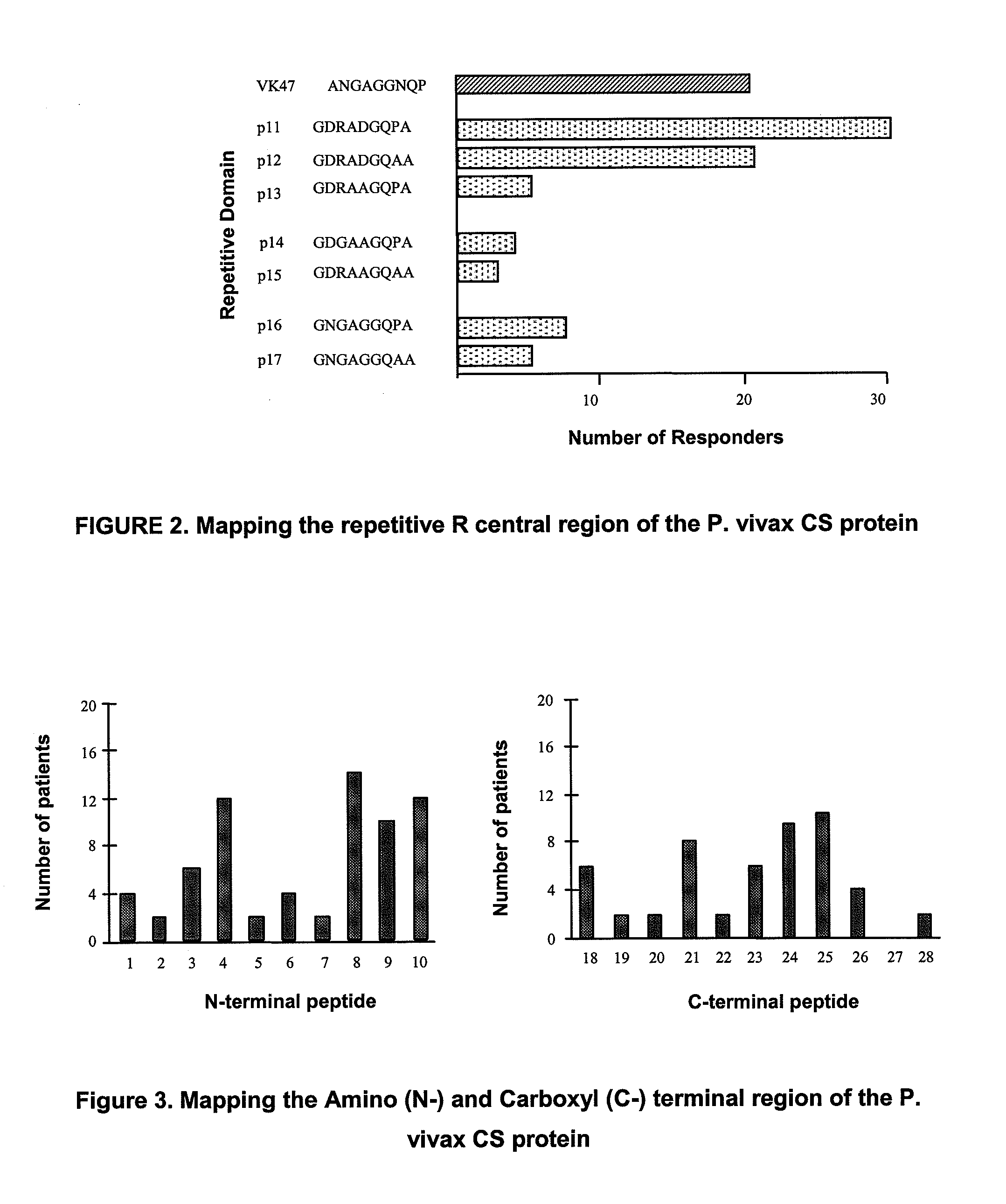Malaria vaccine based on fragments and combination of fragments of the cs protein of plasmodium vivax
a technology of plasmodium vivax and cs protein, which is applied in the field of malaria vaccines, can solve the problems of high morbidity, increased non-immune individuals, and exposure to infection and its complications
- Summary
- Abstract
- Description
- Claims
- Application Information
AI Technical Summary
Problems solved by technology
Method used
Image
Examples
example 1
Identification of Segments of Interest for the Invention
[0063]Epitopes B, T helpers and T-CD8+ are considered relevant as segments of interest to be included in a vaccine for the present invention. In order to identify B epitopes, 28 peptides from 20 overlapped residues in 10 residues each (FIG. 1) were synthesized, which were studied using serum from different individuals previously exposed to malaria and considered carriers in different grades of clinical immunity. From the 7 peptides used in the analysis of the central repetitive region, peptide P11 (GDRADGQPA or ANGAGNQPG) was recognized by the major number of individuals (FIG. 2), while from the 21 peptides used for the analysis of flanking regions N and C, peptides p8, p24 and p25 were the most frequently recognized and described as B epitopes (FIG. 3).
[0064]The same overlapped peptides were used in cellular proliferation tests in order to identify the T helper epitopes using peripheral blood lymphocytes (PBL) from the same in...
example 2
Pre-Clinic Essays of Immunogenicity in Mice
[0070]BALB mice were used to determine the immunogenicity of the peptides (N, R, C) administered by intraperitoneal (IP) and subcutaneous (SC) ways both individually and in combined form. The peptides were formulated in Freund adjuvant. The measure of the antibodies response against each one of the peptides, was carried out through the ELISA technique during several weeks after immunization. The immunization of the mice induced a vigorous antibodies response (1:80,000-1:1,000,000), in particular against N and R peptides. (See FIG. 7).
example 3
Pre-Clinic Essays on Immunogenicity in Non-Human Primates
[0071]The immunogenicity of combinations of the same long peptides was studied in Aotus lemurimus monkeys, which received 3 dose of 100 μg of each of the peptides N, R and C formulated in the Montanide ISA 720 adjuvants and in the complete and incomplete Freund adjuvants. The immunizations unchained high antibodies titles against corresponding peptides N, R and C and the antibodies recognized the native protein of the parasite in immunofluorescence tests. (FIG. 8)
PUM
| Property | Measurement | Unit |
|---|---|---|
| Electrical conductance | aaaaa | aaaaa |
| Chemical shift | aaaaa | aaaaa |
| Current | aaaaa | aaaaa |
Abstract
Description
Claims
Application Information
 Login to View More
Login to View More - R&D
- Intellectual Property
- Life Sciences
- Materials
- Tech Scout
- Unparalleled Data Quality
- Higher Quality Content
- 60% Fewer Hallucinations
Browse by: Latest US Patents, China's latest patents, Technical Efficacy Thesaurus, Application Domain, Technology Topic, Popular Technical Reports.
© 2025 PatSnap. All rights reserved.Legal|Privacy policy|Modern Slavery Act Transparency Statement|Sitemap|About US| Contact US: help@patsnap.com



